A Man Fleeing from a Unicorn Falls into a Well with a Dragon: Parables in the Legend of Barlaam and Josaphat
The first edition of the Sacrum Martyrologium Romanum published in 1584 lists 27 November as the feast day of Barlaam and Josaphat. The text contains the following note on these saints, “In India at the borders of Persia, the Saints Barlaam and Ioasaph, whose wonderful deeds were recorded by Saint John of Damascus”. Both saints will probably not be familiar to present-day readers and their names are not found in more recent versions of the Martyrologium. During the Middle Ages, on the other hand, the story was wildly popular throughout Europe. The story itself is set in India in the third or fourth century CE and the basic plot is as follows.
After the birth of his son Josaphat, the Indian king Abenner is told by an astrologer that his son will become a Christian. Many in India had been converted by the Apostle Thomas, and in the time of Abenner, many monks had come into the country. Threatened by the growing influence on the population, Abenner had persecuted the monks and other Christians. In order to prevent his son from becoming a Christian, he sends him to live in isolation in a luxurious palace in a distant city so that he would not come in contact with human suffering and death. Josaphat grows up and becomes an intelligent young man. But he also grows unhappy with being confined to the palace and the king grants him the opportunity to go outside under supervision. One day, when his attendants are careless, Josaphat sees a maimed and a blind person, and later also an old person. The prince is very troubled by the reality of sickness and death. Now a very pious monk, named Barlaam, learns about the prince’s troubled state of mind. He travels to the city and manages to visit the prince in the palace disguised as a merchant. After a long conversation, in which Barlaam instructs Josaphat in the teachings of Christianity, the prince is baptized by the monk. After learning about his son’s conversion, Abenner seeks to persuade his son to abandon his new religion. He even tries to tempt him with beautiful women. However, when all of his attempts fail, he divides his kingdom. Josaphat becomes a great ruler in his part of the kingdom. In the end, his father repents and is also baptized. After the death of his father, Josaphat turns over his rule to his friend Barachias and sets out to find Barlaam in the wilderness. When he finds the monk, the two of them live as ascetics for many years. After learning about the death of the monk and the prince through a vision, Barachias has their bodies brought back to the city, causing many miracles to occur.
The version of the story related above is from the Greek version attributed to John Damascene (8th century), although his authorship has been disputed. Many scholars have argued that the Greek version was the work of the Euthymios, the abbot of Iviron, Mount Athos (10th-11th century). It was translated into Latin during the Middle Ages in several versions, for example in the well-known Legenda Aurea by Dominican Jacobus de Voragine (13th century), from which it found its way into numerous late medieval and early modern vernacular languages, like French, German, English, Norwegian, and Dutch. However, the Greek version attributed to John Damascene is not the original. In the 19th century, it was noticed that the story of Barlaam and Josaphat has a lot in common with the life of Buddha. Several key points in the story about prince Josaphat can also be found in various early Indian versions of the life of the prince Siddhartha Gautama (for example Aśvaghoṣa’s Buddhacarita, 1st-2nd century CE). He was locked up in a palace after the prediction of sages that he would become a great king or a holy man. He was confronted with suffering when leaving the palace for the first time and seeing an old man, a sick man, and a dead man. He was tempted with women to return to his former life. The French scholar Edouard de Laboulaye is often credited as the first to notice the parallels. Already in 1446, however, a Venetian editor of the travels of Marco Polo wrote a brief comment on the account of the life of Buddha in this work, stating that it was “like the life of Saint Iosafat who was son of the king Avenir of those parts of Indie, and was converted to the Christian faith by the means of Barlam, according as is read in the life and legend of the holy fathers.” Indeed, the Greek story presents a Christianized version of the life of Buddha, which contains elements of extant early Indian sources, but is not identical to any of these. But how did a version of this story finally reach Europe? The Greek text was translated from a Georgian original, which in turn is thought to be based on an Arabic version (Kitab Bilawhar wa Budhasaf). The Arabic probably came from a Manichaean original based on Buddhist traditions known in Persia and transmitted in Manichean Middle Persian. The transmission history is reflected by the change of names. Josaphat is a Latinized form of Greek Ioasaph, which was based on a Georgian misreading of the Arabic Budhasaf, itself based on the Sanskrit bodhisattva. The saint Josaphat in the Martyrologium Romanum is a Christianised version of the Buddha.
The popularity of the story in medieval Europe is based in part on another interesting feature of the story. Much of the instruction given by Barlaam to Josaphat is in the form of fables or parables (apologues). Several of these parables are taken from the Gospels, for example, the rich man and Lazarus, the wedding banquet, the ten virgins, the prodigal son (with only one son) and the lost sheep (Barlaam and Ioasaph, IX, 72-75; XI, 95-96). In the Greek version Barlaam begins his instruction of Josaphat with the parable of the sower:
“‘There went out a sower to sow his seed: and, as he sowed, some seeds fell by the wayside, and the fowls of the air came and devoured them up: some fell upon stony places, where they had not much earth: and forthwith they sprang up, because they had no deepness of earth: and when the sun was up, they were scorched: and because they had no root, they withered away. And some fell among thorns; and the thorns sprung up and choked them: but others fell upon good ground, and brought forth fruit an hundredfold.’ Now, if I find in thine heart fruit-bearing ground, and good, I shall not be slow to plant therein the heavenly seed, and manifest to thee the mighty mystery. But and if the ground be stony and thorny, and the wayside trodden down by all who will, it were better never to let fall this seed of salvation, nor to cast it for a prey to fowls and beasts, before which I have been charged not to cast pearls.” (Barlaam and Ioasaph, VI, 39).

Image: Relief from Nagarjunakonda, India, showing a man hanging from a branch below an elephant and above a snake, with four cobras emerging from the side and a small animal near his hand. Source: Monika Zin, ‘The Parable of the Man in the Well’, 35. See also http://museumsofindia.gov.in/repository/record/nkm_hyd-mar-scu-0024-21.
Details of the parable differ from the versions found in the Gospels and it is used creatively in a new context. The parable is also found in a medieval Hebrew translation of Barlaam and Josaphat by Abraham Ibn Hasdai (Ben ha-Melekh ve-ha-Nazir, The King’s Son and the Ascetic). Ibn Hasdai removed the names and many Christian elements from the text, but included a lot of new material, including ten additional parables that are not found in other versions of the story. The Hebrew translation was based on one of the earlier Arabic versions, which already contained the parable of the sower. The parable must have been included at an early stage of transmission as part of a Christian reworking of the story. It has even been suggested that it was included because the text already contained an originally Indian example about a sower. Other parables in the Greek version most likely originated in a Buddhist original. A well-known example is the story of the caskets, which was used by Shakespeare in The Merchant of Venice.
The widespread use of similar motifs can be illustrated with another one of these parables probably originating from an Indian original. It is too long to be quoted here in its entirety, but a brief summary will suffice. Barlaam compares people who have become attached to the pleasures of the world to a man fleeing from a unicorn who falls into a well. The man is able to grab hold of a tree, and, placing his feet on a ledge, thinks he is saved. However, he now sees two mice that are gnawing at the root of the tree, and have almost severed it. Looking into the well below, he discerns a dragon. At the same time, snakes begin to appear along the wall of the well. Now, looking up, he notices that there is honey dripping from the branches of the tree. The man instantly forgets about the mortal dangers surrounding him for some of the sweet honey. In the interpretation following the story, Barlaam compares the unicorn to death, the well to the world filled with danger, and the dragon is hell. The honey is the deceptive delights of the world which cause a person not “to take timely thought for (his) salvation.” (Barlaam and Ioasaph, XII, 113). The motif of a person fleeing from one danger and ending up in some other danger, which is often worse, can be found in many fables and parables (see for example the rabbinic parable found in Mekhilta deRabbi Ishmael, Pisha 16). However, the version found here, with the honey and the exotic animals, is unique. It was based on an Indian original which is preserved in various Buddhist sources. The scene is even featured on reliefs found in Nagarjunakonda, India, dating to the 3rd or 4th century CE, depicting an elephant instead of a unicorn.
The popularity of the story of Barlaam and Josaphat during the Middle Ages caused it to be featured in various works of art. The story of the man in the well, in particular, can be found in many places, not only in the form of engravings illustrating editions of the story but also in reliefs in various cathedrals.
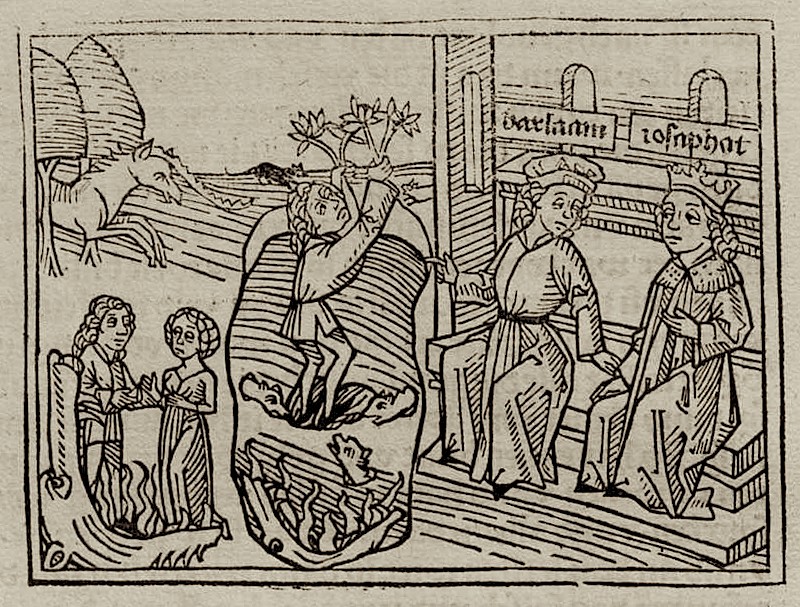
Image: Engraving from Hie vahet an eyn gar loblich vnnd heylsam allen christglaubigen cronica. Sagend von eynem heyligen kunig mit namen Josaphat, Augsburg, ca. 1476. Source: Münchener DigitalisierungsZentrum (www.digitale-sammlungen.de).
Some of these scenes seem to relate to another popular motif in medieval art, namely the representation of the mouth of Hades in the form of a mythical animal based on biblical passages about monsters and the underworld (e.g. Isa. 5:14).
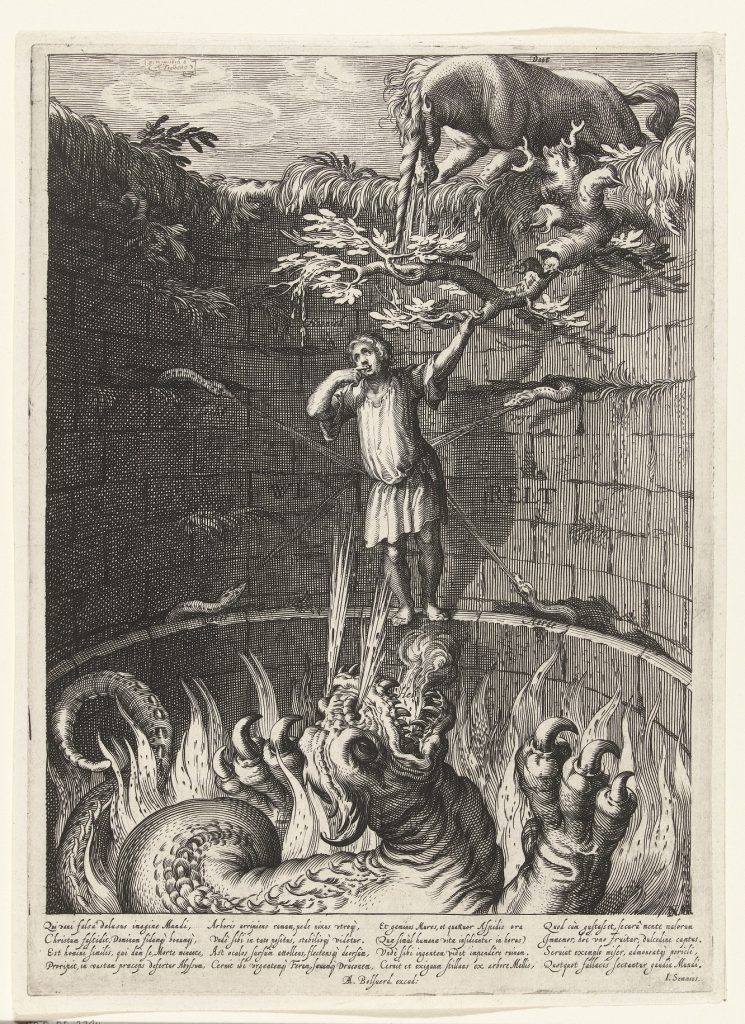
Image: Engraving by Boëtius Adamsz. Bolswert, ‘Allegorie op de wereld’ ca. 1616. Source: Rijksmuseum (www.rijksmuseum.nl).

Image: Relief from the Museo della Cattedrale, Ferrara. Source: petrus.agricola on Flickr (https://www.flickr.com/photos/28433765@N07/8705375208).
The legend of Barlaam and Josaphat shows the wonderfully intricate transmission history of stories and parables as they are creatively reinterpreted and represented in new forms and contexts. It is the creative potential of the parables, which makes it a joy to study these stories.
Further reading
A readily available English translation with a Greek text is St. John Damascene, Barlaam and Ioasaph, transl. G.R. Woodward and H. Mattingly, Loeb Classical Library 34 (Cambridge: Harvard University Press, 1937). Quotes from Barlaam and Josaphat in the text are from this edition.
A text edition of the known versions of the text is currently being prepared as part of a research project at the Norwegian Institute of Philology, see https://www.philology.no/barlaam.
An early vernacular Middle Dutch version of the story in the Legenda Aurea can be found at https://books.google.nl/books?id=YiQZH91fpIQC&pg=PP115.
The reference to Barlaam and Josaphat in the Martyrologium Romanum can be found at https://archive.org/details/bub_gb_wpcmmm1pKrMC/page/n221.
For the reference in Marco Polo, The Description of the Word, trans. A.C. Moule and Paul Pelliot (London: George Routledge & Sons Limited, 1938), 410, see https://archive.org/details/descriptionofwor01polo/page/410.
Bibliography
Tessa Calders I Artís, “The Hebrew Version of the Legend of Barlaam and Josaphat in Catalonia.” Pages 59-83 in Barlaam und Josaphat: Neue Perspektiven auf ein europäisches Phänomen. Edited by Constanza Cordoni and Matthias Meyer. Berlin: Walter de Gruyter, 2015.
Constanza Cordoni, Barlaam und Josaphat in der europäischen Literatur des Middelalters. Berlin: Walter de Gruyter, 2014.
Joseph Jacobs, Barlaam and Josaphat: English Lives of Buddha. London: David Nutt, 1894.
Anique de Kruiff, “A Glimpse of the Beast: Leviathan in Late Medieval and Early Modern Art.” Pages 249-279 in Playing with Leviathan: Interpretation and Reception of Monsters from the Biblical World. Edited by Koert van Bekkum, Jaap Dekker, Henk van de Kamp, and Eric Peels. Leiden: Brill, 2017.
Elsa Legittimo, “La parabole de l’homme dans le puits et la fable du puits du Mūlasarvāstivāda-Vinayavastu.” Pages 259-279 in D’Orient en Occident: Les recueils de fables enchâssées avant les Mille et uni Nuits de Galland (Barlaam et Josaphat, Calila et Dimna, Disciplina clericalis, Roman de Sept Sages). Cultural Encounters in Late Antiquity and the Middle Ages 16. Edited by Marion Uhlig and Yasmina Foehr-Janssens. Turnhout: Brepols, 2014.
Brent Nongbri, Before Religion: A History of a Modern Concept. New Haven: Yale University Press, 2013.
Robert Volk, Die Schriften des Johannes von Damaskos. Patristische Texte und Studien 60-61. Berlin: Walter de Gruyter, 2006-2009.
Monika Zin, “The Parable of ‘The Man in the Well’: Its Travels and its Pictorial Traditions from Amaravati to Today.” Pages 33-93 in Art, Myths and Visual Culture of South Asia. Warsaw Indological Studies 4. Edited by Piotr Balcerowicz. New Dehli: Manohar, 2011.


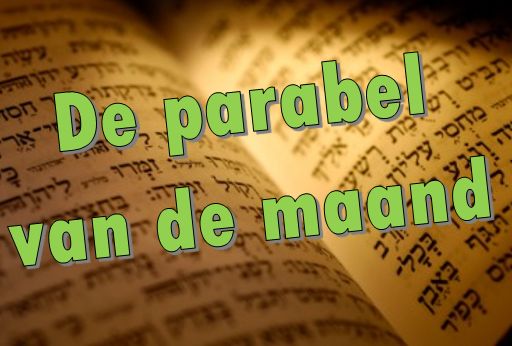
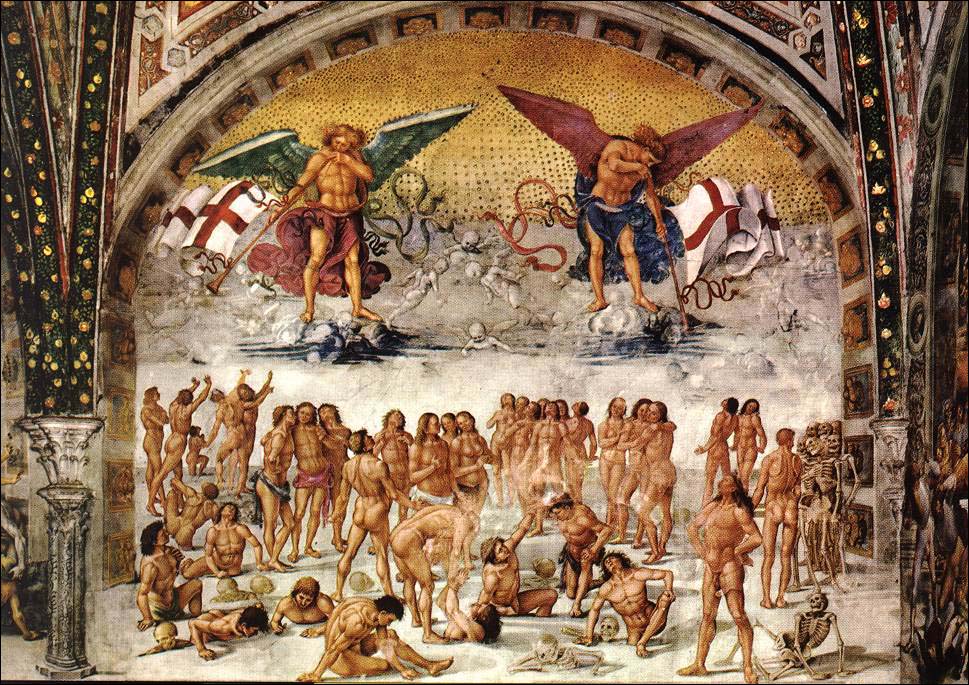
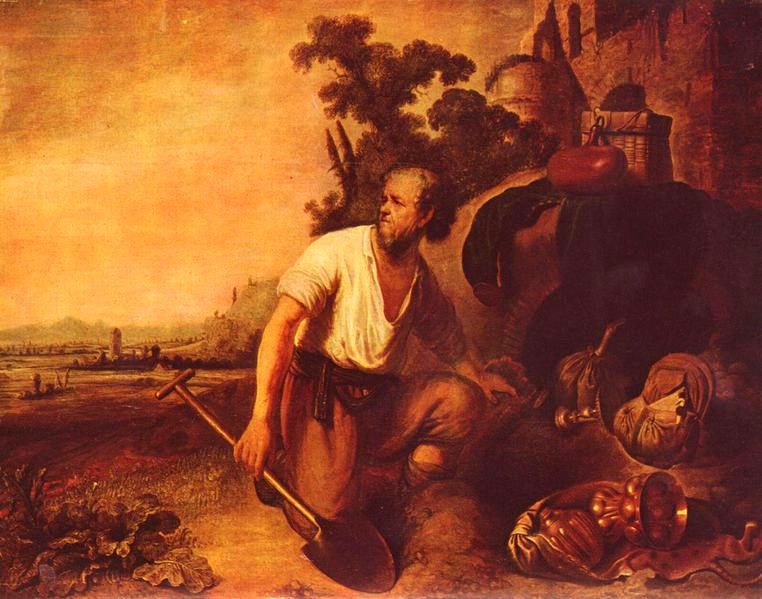
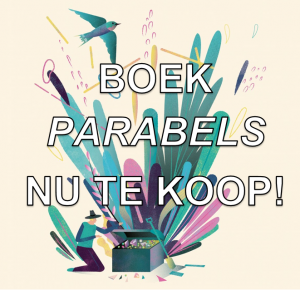
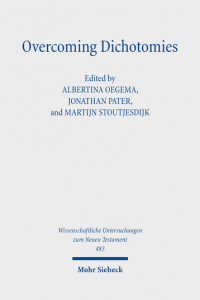
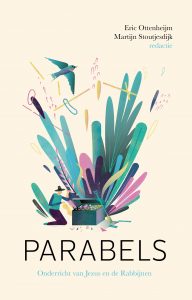
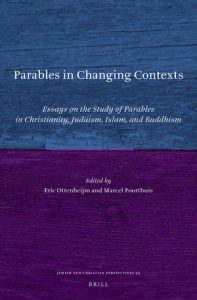
Recente reacties